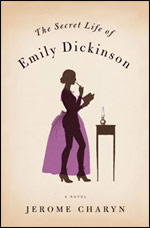 If Emily Dickinson had wanted to make a spectacle of herself, she could have wandered solo into a disreputable “rum resort” to sit on the lap of a not-so-gentlemanly scholar, as Jerome Charyn has her do in his daring novel about the Emily who might have been. As we know, she chose a spectacle of a quieter sort, writing poems that never fail to sparkle, prick and unnerve.
If Emily Dickinson had wanted to make a spectacle of herself, she could have wandered solo into a disreputable “rum resort” to sit on the lap of a not-so-gentlemanly scholar, as Jerome Charyn has her do in his daring novel about the Emily who might have been. As we know, she chose a spectacle of a quieter sort, writing poems that never fail to sparkle, prick and unnerve.
As Charyn assumes Dickinson’s own voice and surrounds her with invented as well as historical characters, “The Secret Life of Emily Dickinson” fits neatly into the flourishing genre of literary body-snatching. These novels, written in the person or from the point of view of a dead great writer, include Laura Joh Rowland’s playful “Secret Adventures of Charlotte Brontë” (Charlotte as sleuth) and Colm Toibin’s insightful novel of Henry James, “The Master,” and let’s not get started on Jane Austen. But all are perfect for the age of too much information. The genre thrives on a contemporary desire to fill in the blanks, and to grant spinsterish ladies the sexual desires they so decorously veiled in their 18th- and 19th-century writing.
Smarter than most yet true to the form, Charyn’s novel is shaped around Dickinson’s obsessive love for several fictional men, dropped into the outline of her actual life. During school days at Mount Holyoke, she develops a distant, enduring crush on Tom, a tattooed, illiterate handyman and pickpocket, who keeps turning up over the years like a treacherous phantom. She almost elopes with the fictional scholar Brainard Rowe after her visit to the rum house, where she feels his “manliness against my flanks,” but her sister-in-law foils the plot. Charyn also gives Emily a doppelgänger, Zilpah Marsh. A poor young servant with a faint moustache, Zilpah is a snake in the grass who keeps stealing Emily’s men, becoming Tom’s lover and earning the affection of Emily’s controlling father.
This walk-on-the-wild-side Emily is no action heroine and eventually becomes the familiar “Queen Recluse.” But even if her youthful wanderings into nasty parts of town are mere fantasies — a possibility the book admits but doesn’t encourage — what do they reveal that isn’t plain from Dickinson’s writing? Yes, she had a passionate side. Weren’t all those phallic snake poems clear enough?
And sadly, Charyn’s greatest risk, Emily’s voice, resembles a clotted mosaic, pieced together from bits of Charyn and shards of Dickinson. She once called herself “the only kangaroo among the beauty”; Charyn’s Emily too bluntly describes herself as a kangaroo who kicks and punches, evidence of her feisty nature. He picks up the nature metaphor “blonde assassin” from one of her poems and applies it to Tom.
The voice doesn’t have to be authentically Dickinson’s, but it ought to sing. In rare moments, it does. “I wore my full armor of feathers under my Dimity gown, and I did not have to fear the sound of my own voice,” she says of a meeting with the real literary figure Samuel Bowles, in a phrase that reveals all the research, invention and sensitivity that should infuse this book.
Charyn has had a long and respected career as a novelist, and he notes in his introduction that he was inspired by Dickinson early in his writing life. “She was a country girl, and I was a boy from the Bronx,” he says. “I was hooked and hypnotized from the start.” Yet that odd-couple ardor has resulted in a novel that, like its arch but generic title, misses Dickinson’s fireworks.
Caryn James is the film critic for Marie Claire magazine and the author of the novels “Glorie” and “What Caroline Knew.”
THE SECRET LIFE OF EMILY DICKINSON
By Jerome Charyn
Illustrated. 348 pp.
W. W. Norton & Company.
The New York Times
Feb 21, 2010